Dog crates or puppy crates can seem a little strange if you’ve never used one before. New puppy owners might not be too keen on the entire idea of putting their dog in an actual cage! However, once you’ve learnt how to use them, they start to make a lot of sense. Puppy crates give a dog a safe space of their own, it encourages independence, helps with toilet training, and can even help avoid some anxiety.
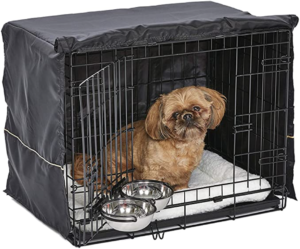
View on Amazon
If you’re wondering if your dog needs a puppy crate, you really just need to think about what a puppy crate can do. No dog specifically needs one. It is a tool you can use when training and caring for your dog. So if the benefits of having a puppy crate for your dog works for you, then you should consider getting one for them.
Crate training is a bit more complicated than it looks on the surface. This is everything you need to know about dog crates; the different types, how to crate train your dog, when to use one, and the potential problems you can avoid.
What Are Dog Crates?
Dog crates or puppy crates are holding cages where a dog can sleep or rest. They typically are a box that can be sealed, which allows your dog to have a space that is just for them. Typically, they’ll use it for sleep or just somewhere to go when they are too stressed out.
Some people are a little unclear on the purpose of dog crates though! This is partially why a lot of people don’t think a dog crate is for them. Dog crates aren’t used as a punishment. It isn’t a cage you put your dog in to give them a time out. This is a space where your dog can feel comfortable and secure. It encourages their natural instincts for dens. This is what helps with puppy training and to give a dog a secure place to go.
These are the main benefits of going through crate training:
- Your dog has a place that is safe to them, where they can go when stressed or nervous.
- Toilet training is considerably easier. They’re naturally inclined not to go where they sleep.
- It can help your dog when you’re moving to a new space since it is a familiar place.
- Your dog can go here when they’re not supervised, it is a safe space.
- Your dog has a comfortable place to be when travelling.
- It can help with separation anxiety by giving your dog a secure space, where they’re used to being alone.
Different Types of Dog Crates
Dog crates aren’t one size fits all or just a simple unit. Like most things you can get for your pet, there are a lot of options out there if you want to look around. These are the main types of dog crates you’re likely going to see:
- Metal Dog Crates – Metal dog crates are made from wire or metal, looking a bit more like a typical cage for a smaller animal. These come in larger sizes. They have a soft plastic bottom to put a crate bed onto. These are the easiest for use at home or for bigger dogs.
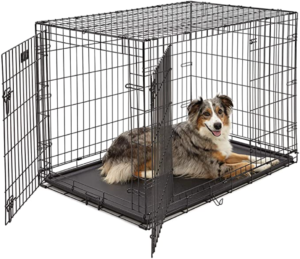
View on Amazon
- Soft Dog Crates – Soft dog creates, or soft sided crates, are dog crates that are made from a fabric of texture rather than from hard metal. These crates are soft, and they’re a little less stern looking than the alternative. They’re also lighter and easier to transport, making them great for when you’re travelling. They can be a bit flimsy for bigger dogs though.
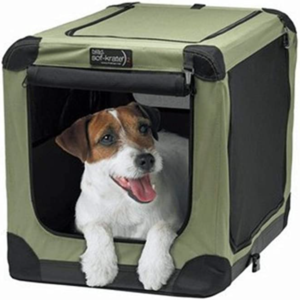
View on Amazon
- Plastic Dog Crates – Plastic dog crates are the same as the others, but made from plastic. These ones tend to be smaller, and good for travelling. Not fantastic everyday though, in case your dog scratches or bits the plastic walls and gets shards of plastic in there. They could be a choking hazard.
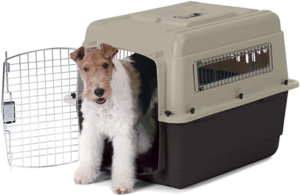
View on Amazon
The variety of dog crates largely come down to material. You’ll have to decide which is best for your dog, but metal ones tend to be best for bigger dogs or at home use.
How to Crate Train Your Dog
Once you’ve picked a crate for your dog, you’ll have to train them to actually use it! This is easiest when your dog is a puppy, but you can do it when they’re an adult too. This is what you’ll need to do:
- Set Your Crate Up – Try to do this while your dog isn’t in the room as all of the noise could upset or unsettle them. Put the crate somewhere away from direct sunlight, or anything around on the floor that could grab their attention.
- Put a Bed or Blanket in the Crate – Give your dog a comfortable place to sleep within the crate.
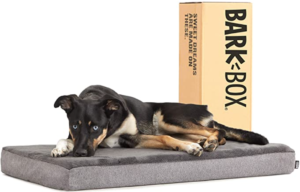
View on Amazon
- With the Door Open, Allow Your Dog Inside – Step away for a little and leave the door open. The crate should be accessible to your dog. If they go inside of their own accord to explore, reward them. Every now and again give them a treat or a toy inside to build up a happy association.
- Repeat This for a While – Rewarding your dog for going inside should continue for a little while. This helps them get comfortable there. Over time, your dog should begin to settle in there themselves occasionally.
- Gradually Shut the Door – With your dog now settling inside the crate themselves, you can begin to occasionally shut the door on them. This should be gradual. So at first just move the door a little more shut. Doing this slowly helps to build up their confidence and avoids a negative reaction.
- Build up the Time Inside the Crate – Have longer periods with your dog inside of the crate to build up their confidence.
When to Leave Your Dog in a Dog Crate?
Once your dog is crate trained, they have a safe space to go which should help with toilet training. However, it is also a place you can leave them when you’re unavailable to watch them. A space where they’ll feel safe and secure. However, it isn’t the best solution for where to leave your dog for a full day when you’re working.
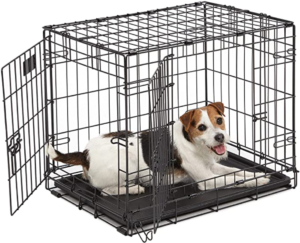
View on Amazon
An adult dog will be okay in the crate overnight, or for 5 ish hours during a day. However, puppies won’t be able to hold their bladders that long. On top of this, the aim is to make the crate a safe space that they like being in. Putting your dog in there for excessive time while they’re alone will make them dislike the crate. So a crate is good for training your dog and giving them their own space, it isn’t the best idea to leave your dog in one when you’re out of the house for an extended period. Especially when they’re a puppy.
Travelling With Dogs and a Crate
A dog crate can make travelling with your dog significantly easier! It gives them a secure place to be while in a car. Once you travel to somewhere new, their dog crate has familiar smells and feel which can help your dog feel more at home. They will have their own space and bed there, despite the new surroundings. If you’re travelling with a dog crate though, there are a few things to bear in mind.
The first is your type of crate. The softer types of dog crate are significantly easier to transport. This might mean you’ll need a separate travel crate if you travel a lot. If this is the case make sure you run through the crate training with both crates. If the crate is brand new then it will be confusing to your dog.
Another thing to keep in mind is actually transporting your dog. Some countries require dogs to be secure in a car, with dog seat belts or a fully secured crate. Be sure to check what the rules are for your dog before travelling with them. Even if they’re in the crate while travelling, the same time restrictions apply too. Your dog needs to be let out of the car for a quick walk and fresh air fairly often.
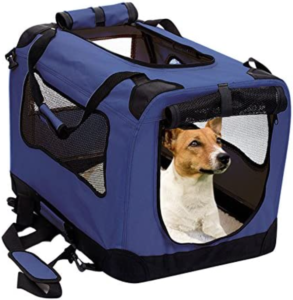
View on Amazon
Potential Problems with a Dog Crate
Crate training a dog can be a big help towards things like toilet training. However, there are some potential pitfalls which new dog owners can often fall into with puppy crates. These are the main ones, and how to avoid them:
- Leaving Them in Too long – Leaving your dog in the crate for too long is going to give them a bad impression of the crate. This will completely ruin the training! Your dog needs to like the crate, not hate being in there! Don’t treat it as a punishment or as a holding cell.
- Size – Make sure your dog crate is the right size for them! A big dog needs a big dog crate, and a small one can make do with a smaller one. If it is too small for them, it will be uncomfortable. If it is too big, then it will undermine the benefits for toilet training as there is more space outside of a dog’s bed to use as a toilet.
- Food and Water – Some people leave water in the crate if it is big enough. However, food probably shouldn’t be kept in there. The dog bed isn’t for meal times.
- Stopping Once They’re Grown Up – Many people use puppy crates to help toilet train their dogs. However, they often then stop using them once their dog is an adult. Your dog crate should be a comfortable and safe place for your dog.
If you can steer clear of these problems, then your dog training should go quite a bit smoother! Crate training a dog can make it much easier to train them in general, so it is worth pursuing with your dog if they’re having trouble.









